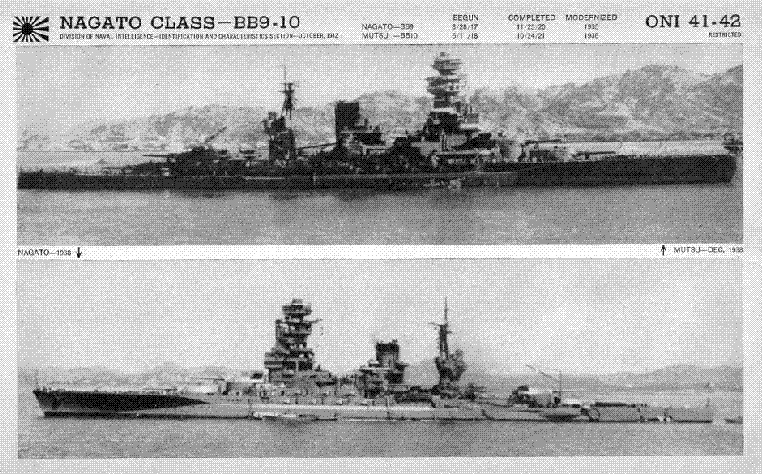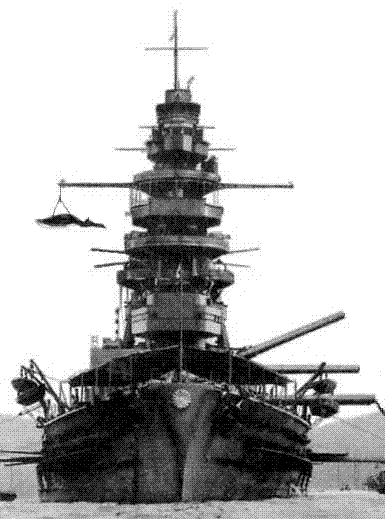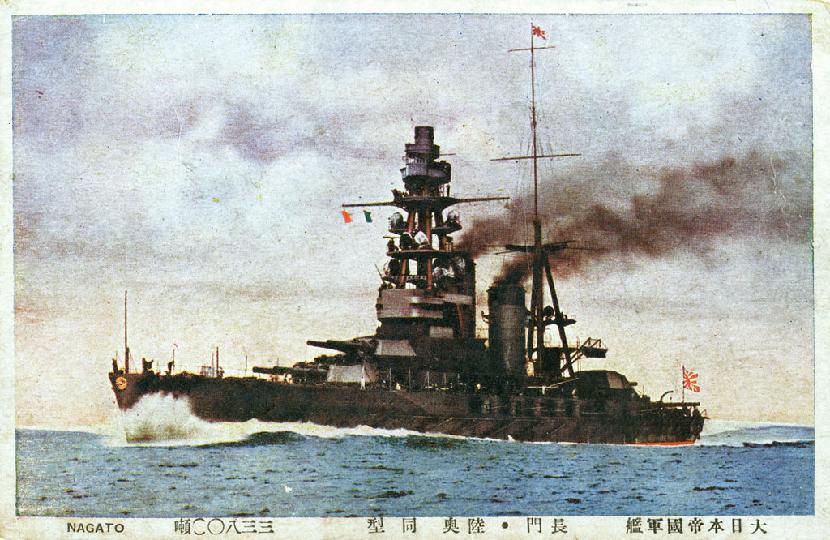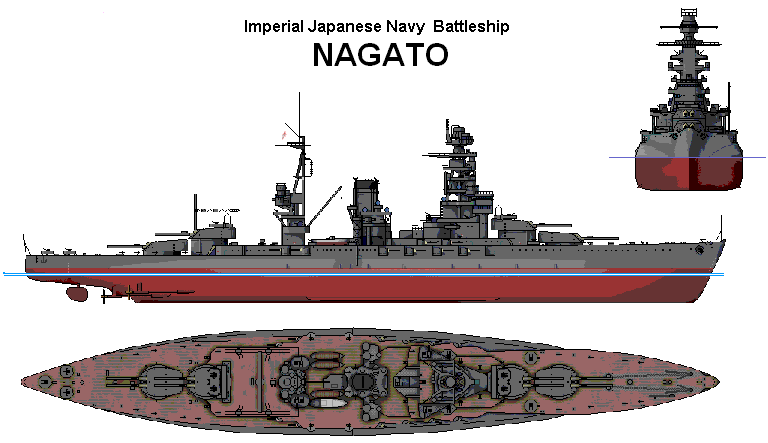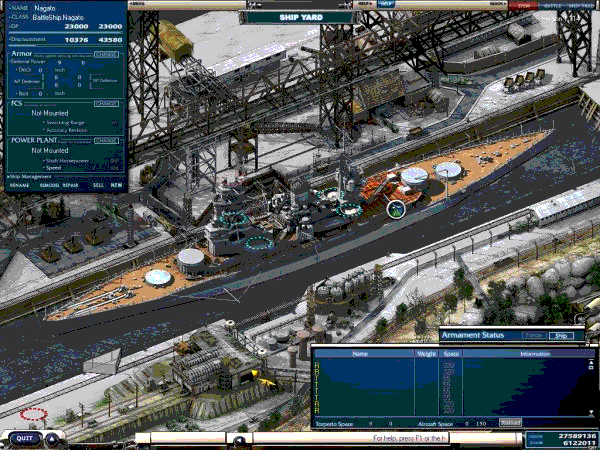
Imperial Japanese Navy - NAGATO class Battleship ==========================================================================
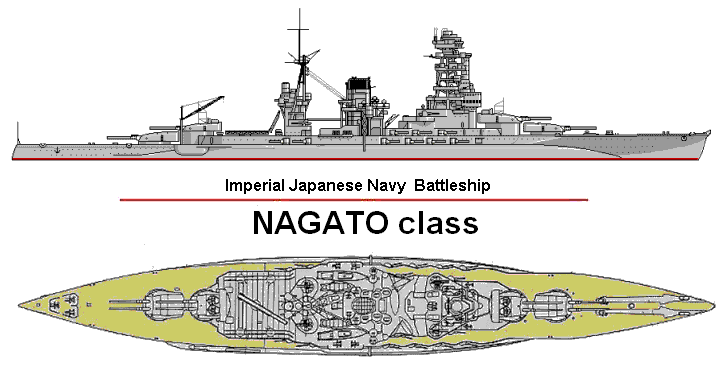
Nagato (named after Nagato province) was a battleship of the Imperial Japanese Navy, the lead ship of her class. She was the first battleship in the world to mount 16 inch class (410 mm) guns, and her armour protection and speed made her one of the most powerful capital ships at the time of her commissioning.
Nagato was laid down at the Kure Naval Arsenal on 28 August 1917, launched on 9 November 1919, and completed on 15 November 1920.
She was the flagship of Admiral Isoroku Yamamoto during the attack on Pearl Harbor. In the war she saw action only once, during the Battle of Leyte Gulf, due to the Japanese Navy's strategy of keeping major units in reserve for a decisive battle.
Nagato was the first Japanese battleship to be designed domestically, as well as the first battleship ever to be built with 16 inch guns. She was designed by Captain Hiraga Yuzuru of the Imperial Navy in the first part of 1916 and by Japanese accounts placing her several months ahead of the USS Maryland, an American ship of similiar capability. The Nagato was laid down on 28 August 1917 at the Kure Naval Yard and completed over three years later on 25 November 1920.
Nagato and her sister ship, Mutsu, were built with speed in mind and were very similiar to the British Queen Elizabeth class battleships in this regard. In sea trials in 1920, the Nagato clocked in at 26.7kts, a blistering speed at the time for battleships. In regard to armor, the Nagato class resembled the American "All or Nothing" practice in regard to naval armor. That is, due to shell technology in which shells exploded after breaching thin armor, it was deemed better to replace it with either very heavy armor or none at all. Despite adhering to the practice, the Nagato's Japanese designers did not feel comfortable without adding armor to the lower deck, something not found on American ships. A particular detail of the armor arrangement involved protection of the torpedo bulkhead which was sloped out to meet the armor deck, and provided complete protection. The design was later incorporated into all future capital ships.
They were the first battleships in the world to mount 16 inch class (410 mm) guns, and their armour protection and speed made them the most powerful capital ships at the time of their commissioning.
After the Washington Naval treaty prohibited major naval powers from building more battleships, they were extensively modified in the 1920s and 1930s.
The Nagato class were also equipped with the identifable heptapodal mast unique to Japanese ships. These masts consisted of one thick vertical mast in the center with two legs which sloped forward towards their perspective beam, port or starboard. Inteference from smoke was also a problem for the masts, which were placed close to the funnels. As a result, the funnels were equipped with smokehoods shortly after test trials were completed.
Like many ships in the Imperial Navy, the Nagato and the Mutsu underwent reconstruction in the mid 1930's for modernization. These modifications included increasing the elevation of the main battery to 43 degrees for a range increase of 8,000 meters. Both ships also received more armor in the areas of gun turrets, barbettes, and deck protection over the machinery. In total, the ships received an additional 2,600 tons of armor. Their machinery was refurbished, but not replaced, unlike other ships in the time period going through similiar reconstructions.
Both ships were operated during the Second World War, but only the Nagato survived. The Mutsu was sunk, not by Allied efforts, but from an internal explosion (her magazine the most likely source) which sent her to the bottom of the Inland Sea. The Nagato was taken by the United States as a war prize and was used by the Navy to test the affects of an atomic bomb detonation on a surface fleet at the Bikini Atoll. She survived the intitial air burst test and remained afloat for five days following an underwater blast before finally succumbing to massive hull damage and sinking.
At the outbreak of World War II, Nagato, under the command of Captain Yano Hideo, and her sister ship Mutsu formed Battle Division 1. Nagato was the flagship of the Combined Fleet, flying the flag of Admiral Yamamoto Isoroku. On 2 December 1941 Nagato sent the signal Niitakayama nobore 1208 "Climb Mount Niitaka on 12/08 (Japanese Time)" that committed the Carrier Strike Force to the attack on Pearl Harbor and Japan to the Pacific War.
On 12 February 1942 Admiral Yamamoto transferred his flag to the new battleship Yamato.
Nagato sailed with the Yamato, Mutsu, Hosho, Sendai, nine destroyers and four auxiliary ships as Admiral Isoroku Yamamoto's Main Body during the Battle of Midway in June 1942 but saw no action. She returned the survivors of Kaga to Japan.
In 1943, under the command of Captain Hayakawa Mikio, Nagato was based at Truk in the Caroline Islands. After the evacuation of Truk in February 1944, she was based at Lingga near Singapore.
In June 1944 she took part in Operation A-Go, an attack on Allied forces in the Mariana Islands. In the battle of the Philippine Sea on 19 June 1944 she came under air attack but was not damaged.
In October 1944 she took part in Operation Sh�-1, an attack on the Allied landings on Leyte. On 24 October 1944 in the battle of the Sibuyan Sea Nagato was attacked by several waves of American dive-bombers. At 14:16 she was hit by two bombs dropped by planes from Franklin and Cabot. The first bomb disabled a number of guns and damaged the air intake to the No. 1 boiler room, stopping one shaft for 25 minutes until the air intake was cleared. The second bomb hit the canteen and forward radio room, killing 52 and wounding 106. On 25 October the Central Force passed the San Bernardino Strait and headed for Leyte Gulf. In the battle off Samar, Nagato engaged the escort carriers and destroyers of the US Task Group 77.4.3. At 06:01 she opened fire on St. Lo, the first time she fired her guns at an enemy ship, but missed. At 06:54 the destroyer Heermann fired a spread of torpedoes at Haruna; the torpedoes missed Haruna and headed for Yamato and Nagato on parallel courses. The two battleships were forced to turn away from the action to the north for 10 miles (16 km) until the torpedoes ran out of fuel. After returning to the action, Nagato continued to engage the American carriers, firing 45 16 inch (406 mm) shells and 92 5.5 inch (140 mm) shells.
At 09:10 Admiral Takeo Kurita ordered the fleet to break off the engagement and head north. At 10:20 he ordered the fleet south again, but as the fleet came under increasingly severe air attack he ordered a retreat again at 12:36. At 12:43 Nagato was hit on her bow by two bombs but the damage was not severe.
As it retreated on 26 October the Japanese fleet came under continuous air attack. Nagato was attacked by dive-bombers from Hornet and hit by four bombs, suffering 38 killed and 105 wounded. In the course of the day she fired 99 16 inch (406 mm) shells and 653 5.5 inch (140 mm) shells.
On 25 November 1944 Nagato arrived at Yokosuka, Japan for repairs. Lack of fuel and materials meant that she could not be brought back into service, and in February 1945 she was reassigned as a coastal defence ship. In June 1945 her secondary and anti-aircraft armament were moved ashore. On 18 July 1945 she was attacked at Yokusuka by fighter bombers and torpedo bombers from Essex, Randolph, Bennington, Shangri-La and Belleau Wood and hit by three bombs, one hitting the bridge and killing her commanding officer, Rear Admiral Otsuka Miki.
On 30 August 1945, following the Japanese surrender, Nagato, the last surviving Japanese battleship still afloat, was boarded and secured by American sailors from the ship USS Horace A. Bass (LPR-124).
Given to the Americans as a war prise, the vessel was slatted for use as a target in the nuclear tests at Bikini Atoll. A crew of 180 Americans, with the assistance of several Japanese officers, took the old battlewagon for three short familiarization cruises around Tokyo Bay, then set off on the 2400 mile trip to Bikini in the company of the captured light cruiser Sakawa. With only two of her four screws in operation, Nagato managed only 10 knots. The makeshift crew suffered through cold seawater showers, as the freshwater condensers were barely functional, and the poor repairs to the hull soon began to leak. The punps were unable to keep up, and soon 150 tons of water leaked in forward, which in turn had to be offset by 250 tons of counterflooding aft. On the 8th day, about halfway to Bikini, the battleship had to turn about and take her companion in tow as the smaller vessel developed propulsion trouble. Nagato soon blew out a boiler herself, and the two vessels drifted helplessly for two days until rescued by US Navy tugs. The battleship, without power, lights, or pumps, developed a 10-degree list to port, and refused to be towed at more than 4 knots. On the 18th day of what was supposed to be a 10 day trip, the vessel was finally towed into Enewetak, about 200 miles from her final destination. After three weeks of repairs, the last Japanese battleship sailed under her own power, at a brisk 13 knots, to her designated spot at Bikini.
In March 1946 she was taken to Bikini Atoll for Operation Crossroads, a series of atomic bomb tests.
Nagato survived the first, atmospheric, nuclear blast with fairly minor damage, but sank from massive hull damage five days after the second, underwater blast.
In the first test (ABLE, an airburst) on 1 July 1946 she was 1,640 yards from ground zero and was not severely damaged. In the second test (BAKER, an underwater explosion) on 25 July 1946 she was severely damaged, and eventually capsized and sank five days later.
Today, the Nagato rests upside down in 180 feet of water. The 708 foot long hull is intact, and rests on the ship's massive superstructure. This allows access to all four of her twin 16" turrets, which did not fall off when the ship capsised, as is often the case. The bridge snapped off when she settled, and it laysnext to the rest of the wreck, giving divers the oportunity to swim where Yamamoto stood when he launched the Pearl Harbor attack. The water is warm, with plenty of ambient light. Nagato is, without a doubt, the best battleship dive in the world.
The Naval Ensign of Nagato was taken by a commander of the US Navy. It was put on an antique appraisal show, Nandemo Kanteidan, by his daughter, and broadcasted on TV Tokyo in September 2005. The Ensign was evaluated at 10 million yen. After the show, the host of the show Kouji Ishizaka bought the Ensign at 10 million yen and donated to Battleship Yamato museum in Kure, Hiroshima in September 2006
In Tora! Tora! Tora!, a film depicting the attack on Pearl Harbor and the events that led to it, a large, accurate fullscale replica of Nagato was built, which is first seen in the opening credits of the film.
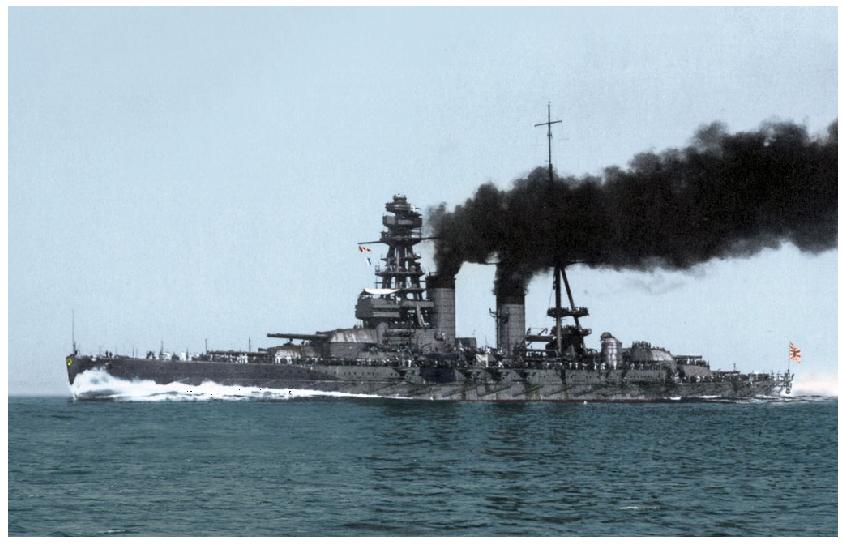
=================================================================================
NB: The above text has been collected / excerpted / edited / mangled / tangled / re-compiled / etc ... from the following online sources :
IJN - Nagato Class Battleship - wikipedia article #1
IJN - Nagato Class Battleship - wikipedia article #2
IJN - Nagato Class Battleship - www.globalsecurity.org
IJN - Nagato Class Battleship - www.bobhenneman.info
IJN - Nagato Class Battleship - www.uniteddivers.com.au

